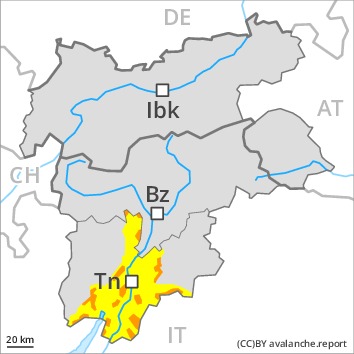
Danger level
 | treeline
|
Avalanche Problem
 | | Wind-drifted snow |
|  | |  |
 | | Gliding snow |
|  | |  |

More gliding avalanches are possible. Fresh wind slabs are to be evaluated with care and prudence.
More gliding avalanches are possible in the afternoon, but they will be mostly small. Caution is to be exercised in particular on rather lightly snow-covered sunny slopes.
The fresh wind slabs are to be evaluated with care and prudence in particular on west to north to east facing aspects above the tree line. The number and size of avalanche prone locations will increase with altitude.
Ski touring calls for experience in the assessment of avalanche danger and careful route selection.
Snowpack
dp.2: gliding snow
Towards its base, the snowpack is moist, in particular at low and intermediate altitudes. Naturally triggered avalanches and snow profiles have confirmed this situation. As a consequence of the moderate to strong wind, snow drift accumulations formed during the last few days, in particular adjacent to ridgelines and in gullies and bowls. This applies above the tree line. The somewhat older wind slabs are covered with new snow in some cases and therefore difficult to recognise.
Tendency
The avalanche danger will decrease gradually.

Danger level
 | treeline
|
Avalanche Problem
 | | Wind-drifted snow |
|  | |  |
 | | Gliding snow |
|  | |  |

On steep grassy slopes natural avalanches must be expected in isolated cases. Fresh wind slabs are to be evaluated with care and prudence.
On steep grassy slopes gliding avalanches are possible in the afternoon, even large ones in isolated cases. This applies in particular on steep sunny slopes below approximately 2500 m. Exposed parts of transportation routes can be endangered.
The new snow and wind slabs of the last few days can be released, especially by large additional loads, in all aspects above the tree line.
In very isolated cases avalanches can be triggered in deep layers of the snowpack and reach very large size. This applies in case of releases originating from very steep starting zones at high altitude that have retained the snow thus far.
Ski touring calls for experience in the assessment of avalanche danger and careful route selection.
Snowpack
dp.2: gliding snow
dp.6: cold, loose snow and wind
As a consequence of the moderate to strong southwesterly wind, snow drift accumulations formed during the last few days, in particular adjacent to ridgelines and in gullies and bowls. The somewhat older wind slabs are covered with new snow in some cases and therefore difficult to recognise. The covering of new snow is fairly homogeneous and has a loosely bonded surface. At low and intermediate altitudes, for the time of year, a lot of snow is lying. Towards its base, the snowpack is moist. Naturally triggered avalanches and snow profiles have confirmed this situation.
Tendency
The weather conditions will bring about a gradual change towards better conditions. Caution is to be exercised in areas with glide cracks.











